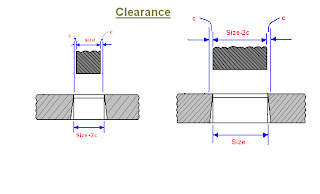terminology used in dies
Terminology used in dies:
1: Clearance
The difference in dimensions between the mating members of a die set is called clearance. This clearance is applied in following manner:
1: when the hole has to be held to size i.e. the hole in the sheet metal is to be accurate (punching operation) , and slug is to be discarded. The punch is made to the size of the hole and the die opening size is obtained by adding clearance to the punch size.
2: In blanking operation , where the slug or blank is the desired part and has to be held to size, the die opening size equals the blank size and the punch size is obtained by subtract.
2: Cutting Forces
In cutting operation, as the punch in its downward movement enters the material, it need not penetrate the thickness of the stock in the order to offset complete rupture of the part. The distance which the punch enters into the work material to cause rupture to take place is called penetrable and is usually given as the %age of the stock thickness
The percent penetration depends on the material being cut and also on the stock thickness. When hard and strong material is being cut ,a very little penetration of the punch is necessary to cause feature. With soft material the penetration will be greater.
3: Strippers:
After a blank has been cut by the punch on its downward stroke, the scrap strip has the tendency to expand. On the return stroke of the punch the scrap strip has the tin deny to adhere to the punch and be lifted by it. This action interface with the feeding of the stroke through the die and some device must be used to strip the scrap material from the punch as it clears up the die block. Such a device is called “stripper” or stripper plate.
Stripper plate are of two types:
1: fixed or stationary
2: spring loaded or movable
(a): fixed or stationary strippers:
This stripper is attached at a fixed height over the die block. The height should be sufficient to permit the sheet metal to be fed freely between the upper die surface and the under surface of the stripper plate. The stripper plate thickness is determining by the formula:
Ts =1/8(w/3+16t)
Where w and t are width and thickness of the stock strip. The fixed stripper is also known as ‘channel stripper”
(b): Spring loaded Stripper:
This type is used on large blanking operations and also on very thin and highly ductile materials. As the punch travels downward for blanking operation the stripping force is determined with the help of following relation. Fs=spt kn
Where p and t are in mm and s is the stripping constant.
4:Pilots:-
Pilots are used in progressive dies. In the design of progressive dies, the first step is to establish the sequence of operations. In this sequence , the piercing operations are placed first. After the holes have been pierced , these holes are used for piloting the blanking punches so that the blank formed is truly concentric to the already punched hole. This piloting is achieved by means of pilots secured under the blanking punch. To be effective the pilot must be strong enough to align the stock without bending. Pilots are made of good grade of tool steel heat treated to maximum toughness and to a hardness of 56 to 60 Rockwell C.
Types of pilots: there are two types of pilots:
(a ): Direct pilot:
Pilots which are mounted on the face of a punch are called direct pilots. The pilot holder is generally a block of steel which can be fastened to the punch holder.
(b) Indirect pilot:
Such pilots are well guided through the hardened bushes in the stripper plate.
5: Stock Stop:
The strip of sheet metal is fed and guided through a slot in the stock guide or through a slot in the stripper plate after each blanking. The strip has to be advanced a correct distance, the device used to achieve this is called “ stock stop”


 3:20 PM
3:20 PM
 , Posted in
, Posted in


